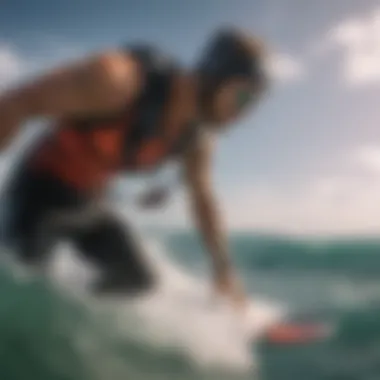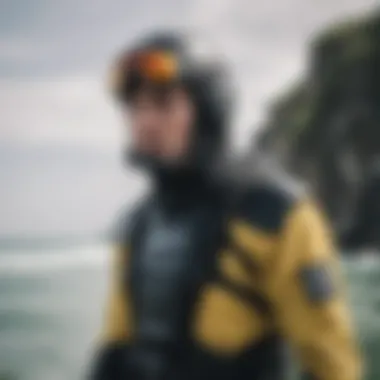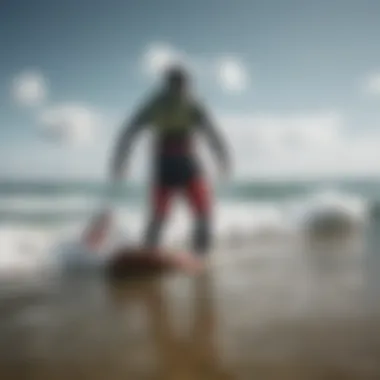Kitesurfing Clothing: Gear, Style, and Sustainability


Intro
Kitesurfing, a blend of surfing, windsurfing, and paragliding, has grown into a popular water sport over the years. But just like any sport, the right clothing and gear can make a world of difference. Not only does functional attire enhance performance, but it also adds to the visual appeal as surfers cut and carve through the shimmering waves. As with any journey into a thrilling sport, understanding what to wear, how to protect oneself from the elements, and looking good while doing it is essential.
In the realm of kitesurfing clothing, enthusiasts face a myriad of choices from materials to styles. Factors like ocean temperature, wind intensity, and personal comfort come into play. This guide aims to offer a thorough examination of these choices, ensuring that both beginners and seasoned surfers can navigate the waters—literally and figuratively—while remaining stylish and environmentally conscious.
Surf Gear and Equipment
When it comes to kitesurfing, the right gear is pivotal. Each piece serves a purpose, working together to make your experience safe and enjoyable. The first step is comprehending the essentials.
Latest Surfboard Technologies
Surfboards designed for kitesurfing have evolved dramatically. From traditional designs to cutting-edge innovations, surfers now have a wider range of options than ever. Popular materials include:
- Epoxy: Lighter and more durable than traditional fiberglass, epoxy boards float better and are less prone to dings.
- Carbon Fiber: Known for its superior strength-to-weight ratio, carbon fiber boards provide enhanced performance and responsiveness.
- Foil Boards: These have gained traction, allowing surfers to glide above the waves, tapping into a new dimension of maneuverability.
Choosing the right board hinges on various factors: your weight, skill level, and the conditions under which you'll be riding. Are you catching waves in a small lake or tearing through rugged ocean swells? Tailoring your choice to your environment can make a significant difference in your experience.
Essential Accessories for Surfers
Every surfer knows that accessorizing isn't just for fashion—it’s essential for functionality. Now let’s break down some key accessories:
- ** harness**: A good harness distributes the pull from the kite uniformly, ensuring comfort and minimizing fatigue.
- Impact Vest: This isn’t just for show; it’s a smart choice that provides extra buoyancy and reduces the risk of injury during falls.
- Waterproof Phone Cases: In today’s digital age, being able to capture your exploits can add a splash of fun. Waterproof cases are a must to keep tech gear safe.
- ** booties**: These provide grip and warmth, particularly in cooler waters. Selecting the right thickness can enhance comfort and performance.
Carefully considering these accessories can further enhance your kitesurfing experience, offering both safety and an element of personal style.
"Choosing the right gear is half the battle. The other half is knowing how to work with it."
Understanding kitesurfing clothing goes beyond picking out a few flashy items—it's about creating an experience that marries function with style. As we dive deeper into protective wear and sustainable choices, we'll uncover the ways in which kitesurfers can prepare for the elements while looking good on the water.
Foreword to Kitesurfing Clothing
Kitesurfing is not merely a sport; it’s a lifestyle that demands particular gear, especially clothing. Choosing the right attire goes beyond mere aesthetics. The right clothing not only enhances performance but also provides essential protection against various elements. Understanding kitesurfing clothing ensures that enthusiasts, whether new to the sport or seasoned veterans, can enjoy their time on the water with confidence and style.
Understanding the Basics
When diving into the world of kitesurfing clothing, it’s crucial to understand the basic components that make up this unique gear. Kitesurfing clothing is designed to support the athlete’s movements, keep them dry, and protect them from sun, wind, and potential wipeouts. The core of kitesurfing attire often centers on fabrics that drain moisture quickly, dry fast, and provide adequate UV protection.
- Types of Clothing
- Wetsuits
- Boardshorts
- Rash Guards
Each type serves a distinct purpose, ideal for varying weather conditions and personal preferences.
- Comfort and Fit
- Styles and Designs
- A good fit is non-negotiable. It’s vital that clothing fits snugly but allows for movement. Too loose or too tight can lead to discomfort or even injury.
- The world of kitesurfing clothing is also rich in creativity. From bright patterns to sleek designs, many kitesurfers take pride in expressing their individuality through their gear.
Why Clothing Matters in Kitesurfing
The role clothing plays in kitesurfing goes beyond function to touch on safety, confidence, and even performance improvement. Selecting appropriate clothing dramatically alters the kitesurfing experience. Consider the following:
- Protection from Elements
Coastlines and winds can be unpredictable. Protecting oneself from harsh sun rays, wind burn, and even water impacts is paramount for any kitesurfer. - Injury Prevention
Wearing impact vests or neoprene suits can absorb shocks from falls. These sturdy materials act as a cushion, reducing the risk of injuries. - Psychological Boost
Let’s face it; looking good on the water can boost morale. Feeling confident in one’s attire doesn’t just elevate style; it enhances overall enjoyment during a session.
"The right clothing can be the difference between a stellar day on the water and one you’d rather forget."
In summary, understanding kitesurfing clothing is essential for enjoying the sport to its fullest. It melds functionality, comfort, and style, allowing every kitesurfer to focus on mastering their skills while having a blast out on the waves.
Essential Gear for Kitesurfing
When it comes to kitesurfing, the right gear can make all the difference between a thrilling ride and a miserable day on the water. Proper clothing isn't just about looking good; it serves essential functions like protection from the elements and enhancing your performance. Clothes designed specifically for kitesurfing must be durable, flexible, and comfortable to support the often demanding nature of the sport.
Wetsuits and Drysuits
Wetsuits are often the first thing that comes to mind when discussing kitesurfing clothing. They play a vital role, especially in chilly waters, helping to retain body heat. Drysuits serve a similar purpose but offer more insulation by keeping water out entirely.
Types of Wetsuits


Wetsuits come in a variety of types, including full suits, shorties, and spring suits. Each type has its unique characteristics, contributing to the overall protective quality of your kitesurfing experience. For instance, full suits offer comprehensive coverage for cold weather, while shorties are great for milder conditions. The different styles allow for a broad range of temperatures and conditions.
The key characteristic here is material thickness; typically measured in millimeters, it's critical for maintaining warmth without hampering mobility. A thicker wetsuit provides more insulation but can be cumbersome. On the other hand, a thinner wetsuit offers flexibility at the cost of warmth. In the end, choosing the right type of wetsuit can significantly affect your comfort level and overall performance on the water.
Choosing the Right Thickness
The thickness of a wetsuit should correspond to the water temperature you'll be navigating. This is a crucial decision, as it determines not just comfort but also safety. For example, waters below 60°F usually require a wetsuit with at least 4mm thickness. As a rule of thumb, the thicker the suit, the warmer it is—but also, the less flexibility you’ll have while maneuvering.
It's vital to match the thickness with local climate conditions and personal comfort levels. If you're prone to feeling cold, even slightly warmer temperatures might warrant a thicker suit. However, a thicker wetsuit may also restrict movement, making activity more challenging in the long run.
Fit and Flexibility Considerations
Fit is arguably the most crucial aspect of selecting a wetsuit. An ideal wetsuit should be snug but not uncomfortably tight. A well-fitting wetsuit minimizes water intake, which ensures that you’ll stay warmer and perform better.
Flexibility of the material plays a crucial role here. Neoprene, the most common material used, offers various grades of flexibility. Better-quality neoprene allows for more freedom of movement, making it easier to execute tricks and turns. A poorly fitted or rigid wetsuit can lead to cold water gaps, leading to discomfort and distraction while kitesurfing.
Boardshorts and Rash Guards
Not all kitesurfing moments call for full wetsuits. During warmer conditions, lightweight boardshorts and rash guards provide excellent alternatives. They are popular choices for those who want to enjoy the water without sacrificing comfort.
Material Choices for Comfort
For boardshorts and rash guards, material quality and comfort should be top of mind. Choices like polyester or nylon blends provide durability and quick-drying characteristics, essential for sports like kitesurfing. Stretchable fabrics are especially favored as they allow for a full range of motion.
A key characteristic to note is the use of flatlock stitching, which reduces chafing and increases comfort during prolonged wear. Wearing subpar materials can lead to discomfort and irritation, making it challenging to fully enjoy your time on the water.
Style and Functionality
Boardshorts can often balance fashion and functionality. Different brands and styles cater to various tastes, from vibrant color schemes to simple styles. Most are designed with pockets for convenience, allowing for carrying essentials while out on the water.
However, functionality shouldn't be sacrificed for style. Some shorts include features like quick-dry technology and water-repellent finishes that can make a notable difference. It's essential to select options that support your movement and don’t impede your performance.
Impact Vests and Harnesses
While the exhilaration felt when kitesurfing can be akin to flying, safety gear is a non-negotiable aspect of the sport. Impact vests and harnesses are essential for ensuring security while also allowing for freedom of movement.
Importance of Safety Gear
Impact vests offer buoyancy and can cushion your landing should you fall. This piece of gear absorbs shocks from impacts, thus protecting vital areas of your body. A key characteristic of impact vests is that they are often designed to be lightweight while still providing excellent cushioning—allowing you to feel free without skimping on safety.
The unique feature of a good impact vest is its ability to serve multiple purposes. Many come equipped with pockets or attachment points for accessories, like safety whistles. Choosing quality safety gear can not only enhance your overall comfort but play a critical role in injury prevention.
Selecting the Proper Fit
Just like wetsuits, impact vests must fit securely but comfortably. Ill-fitting gear can lead to chafing and discomfort, which can be quite distracting during your fun on the water. A snug fit ensures that the vest will remain in place during heavy action, fully supported.
The unique feature of some modern impact vests is the inclusion of adjustable straps, allowing customization for individual preferences. Ensuring that your vest is properly fitted can amplify the effectiveness of the safety features, significantly improving your overall kitesurfing experience.
Material Innovations in Kitesurfing Clothing
When it comes to kitesurfing, the importance of material innovation cannot be overstated. The right materials can greatly enhance the performance and comfort of kitesurfing clothing, affecting everything from flexibility and insulation to durability and sustainability. With the advancement of technology and a growing awareness of environmental issues, many brands are focusing on innovative materials that can keep water sports enthusiasts comfortable and safe while also being mindful of their ecological footprint.
Neoprene vs. New Materials
Performance Characteristics
Neoprene has long been a staple in the world of kitesurfing apparel, providing warmth and insulation in wet conditions. One of its key characteristics is its ability to offer thermal protection, which is particularly beneficial during colder months or in chilly waters. It is flexible, which allows for a wide range of motion while riding the waves, ensuring that kitesurfers don’t feel restricted. However, over the years, alternatives to neoprene have emerged.
Newer materials often feature lightweight composites that enhance breathability and moisture-wicking capabilities. These materials are designed to dry quickly, which is vital when you're transitioning from the water back to the shore. Dual-layer fabrics integrate recycled materials that provide similar warmth to traditional neoprene while being more environmentally friendly. These features make modern alternatives a popular choice and a notable consideration for kitesurfers looking to optimize their gear.
Environmental Considerations
In an era where environmental awareness is growing, the impact of material choices on the planet is a significant concern. Traditional neoprene is derived from petroleum, raising questions about sustainability. Alternatives now include natural rubber and bio-based materials that can mitigate these issues. When choosing kitesurfing clothing, one might consider how much of a carbon footprint different materials have.
An important aspect of environmental considerations is the durability of these materials. While some may argue that switching to new materials may sacrifice longevity for eco-friendliness, many of these innovations have proven themself sturdy and can last through the rigors of the sport. Such advancements allow kitesurfers not only to enjoy their passion but also contribute to the planet’s well-being.
Breathable Fabrics for Warm Weather
As kitesurfing tends to be a warm-weather sport, breathable fabrics are gaining prominence. Innovations in fabric technology have led to the creation of lightweight textiles that allow for ventilation and moisture management. These high-performance fabrics help prevent overheating, letting sweat escape while keeping the body cool, even in hot conditions. Considerations can include insulated options designed for high temperatures, which offer both comfort and functionality.


UV Protection and Quick-Dry Technologies
Kitesurfers are exposed to the elements, especially the sun's rays. Hence, UV protection in clothing is becoming increasingly vital. Many brands incorporate UV-blocking technologies in their fabrics to protect skin from harmful rays, allowing athletes to spend hours on the water without the constant worry of sunburn.
Additionally, quick-dry technologies have gained traction. They enable garments to dry almost instantly after exposure to water, enhancing comfort and reducing weight. Staying dry while on the board or after a fall improves the overall kitesurfing experience.
"In kitesurfing, your gear can either make or break your day on the water. Choosing the right materials not only enhances performance but aligns with an eco-conscious lifestyle."
In summary, selecting kitesurfing clothing made from innovative materials can enhance performance while prioritizing the environment. The combination of advanced performance characteristics, breathable options for warmer weather, and UV protection is essential for any dedicated kitesurfer.
The Role of Climate in Choosing Kitesurfing Clothing
Understanding the climate is vital for any kitesurfer aiming to fully enjoy their time on the water. The weather not only affects the conditions of the waves and wind but also significantly influences the clothing choices that enhance performance and comfort. The right attire can mean the difference between a thrilling session and a miserable experience. Moreover, how you prepare for various climates can impact your safety and enjoyment as you take to the skies.
Considerations for Cold Weather
Kitesurfing in cold weather requires a specific approach to attire. When temperatures drop, hypothermia becomes a real threat, so staying warm and dry is a top priority. Here are some key considerations:
- Wetsuit Thickness: A thicker wetsuit is essential in cold conditions. Suits range from 3/2mm to 5/4mm, adjusting to the water temperature you’ll face. Choose thicker suits for colder waters.
- Layering Techniques: Don't just stop at a wetsuit. Consider adding thermal tops or vests under your wetsuit for extra warmth. This layering traps heat without adding bulk, allowing for greater flexibility.
- Accessories: Keep extremities warm with booties, gloves, and hoods. Many people overlook these, but cold feet and hands can spoil a great day. Remember that decisions about these items greatly depend on how frigid the conditions are.
Overall, cold-weather kitesurfing gear must strike a balance between warmth and maneuverability.
Clothing for Warm and Tropical Conditions
On the flip side, kitesurfing in warm or tropical environments presents its own challenges. While it’s tempting to go with lighter options, you must keep several factors in mind:
- Breathability: Fabrics that allow for airflow help in regulating body temperature. Look for clothing labeled as quick-drying and made from breathable materials like polyester or nylon.
- UV Protection: Even on warm days, you should consider how the sun can affect your skin. Clothing with UV protection acts like sunscreen, shielding against harmful rays, which is crucial for extended sessions.
- Lightweight Layers: While it may be hot, having a sun shirt or light outer layer can protect you from both sunburn and wind chill, especially if you're taking a break from kitesurfing.
"What you wear can radically transform your kitesurfing experience, be it sweltering tropical beaches or the chilly coasts."
To sum up, navigating the intricacies of climate considerations in kitesurfing clothing is not just about style but achieving the best performance out there. By understanding the demands of both cold and warm climates, you can tailor your gear to ensure a successful and enjoyable session.
Stylish Kitesurfing Clothing Trends
The world of kitesurfing isn't just about tearing across the waves or catching the ideal wind. It's also a realm of personal expression, where your gear says just as much about you as your skills on the water. This section dives into stylish kitesurfing trends that blend flair with practicality, ensuring that whether you're on land or sea, you look the part.
Fashion Meets Function
In the sport of kitesurfing, fashion and function are bound together like a trusty knot in your lines. The clothing you wear plays a dual role: expressing your style while also meeting the practical demands of the sport. Weather can shift quicker than a rogue wave, and having the right attire not only looks good but keeps you comfortable.
- Breathability: Fabrics engineered for maximum airflow are a staple, keeping you cool when the sun beats down. Materials like polyester and nylon allow moisture to escape, which is key for those sweaty sessions.
- Durability: The ocean's elements are punishing. Stylish kitesurfing gear must be robust. Designers focusing on reinforced seams and abrasion-resistant materials ensure that your duds won’t give up the ghost after a few rides.
- Versatility: A growing trend is clothing that easily transitions from water to land. Think of boardshorts that look good enough for a beach bar while also being functional for a kitesurfing session.
Fashion-forward kitesurfers are now looking at how their choices affect performance without sacrificing aesthetic appeal. A perfect harmony can be found in designs that are both sleek and streamlined, perhaps with a pop of color or a bold pattern. You want to look cool, but functionality should always be steering the ship.
Brand Highlights and Collaborations
As kitesurfing gains traction, various brands are stepping up their game, recognizing the importance of aesthetics in kitesurfing gear. This isn’t just a sport; it’s an entire culture. Collaborations between influential designers and kitesurfing brands have led to innovations that prioritize both style and performance.
- Hurley x Mubar: Their latest line pieces feature unique prints inspired by ocean waves while using lightweight and water-resistant materials. Perfect for those who want to make a splash without compromising comfort.
- O'Neill and Kelly Slater: Known for his surfing prowess, Slater's collaboration with O'Neill delivers not just on performance but also showcases edgy designs. The attention to detail in such blends of art and functionality serves to elevate the kitesurfing experience.
- ION and Local Artists: ION’s recent initiative to showcase local artists on their gear helps push boundaries of kitesurfing fashion. It’s a win-win: artists gain exposure, and kitesurfers get unique gear that truly reflects the spirit of the community.
In this vibrant scene, kitesurfers are not just participants; they are trend-setters, shaping the style landscape with each wipeout and wave.
"Style is about more than aesthetics; it’s about expressing identity through what we wear."
To summarize, stylish kitesurfing clothing trends are crucial in enhancing both the performance and personal expression of kitesurfers. Fashion meets function seamlessly, and these collaborations are paving the way for a future where clothing is as integral to the sport as the water itself.
Eco-conscious Kitesurfing Clothing Options
As the kitesurfing community grows, so does the awareness surrounding environmental impacts. Eco-conscious clothing choices represent a significant shift in how enthusiasts approach their gear selection. The ramifications of this shift extend well beyond aesthetics; they affect the oceans we ride on, the air we breathe, and the communities we impact. When considering the environmental toll that traditional manufacturing processes can exact, opting for sustainable clothing becomes not just a choice but a responsibility.
Choosing eco-friendly kitesurfing clothing means choosing materials and brands that prioritize sustainability, reducing waste, and utilizing processes that are gentler on our planet. These options often come with benefits too: enhanced durability, better performance in various weather conditions, and healthier ecosystems.
Sustainable Materials in Kitesurfing Gear
Material choices for kitesurfing gear have come a long way. Gone are the days when kitesurfers had to choose between performance and environmental consciousness. The industry is seeing a rise in sustainable materials that offer both. Here are some key materials worth noting:
- Recycled Plastics: Many brands are utilizing recycled plastics to create quality boardshorts, rash guards, and even wetsuits. These materials often feature remarkable durability while simultaneously reducing plastic waste in our oceans.
- Organic Cotton: For casual wear, organic cotton serves as an excellent choice. It avoids harmful pesticides that can cause ecological damage, ensuring that the farming process is not just good for the consumer but also for the environment.
- Hemp and Bamboo: Both hemp and bamboo fabrics are naturally sustainable options, known for their durability and breathability. These materials thrive with little water or pesticides, making their cultivation more environmentally friendly.
- Bio-based Neoprene: Traditional neoprene is derived from petroleum, but new innovations are leading to bio-based versions that strive to cut down on greenhouse gas emissions during production.
The transition to these materials doesn’t just help the environment; it resonates with a growing demographic of conscious consumers who appreciate brands that align with their values.


Brands Committed to Sustainability
Some brands are leading the charge in sustainable kitesurfing clothing, making it easier for enthusiasts to make responsible choices. Among them are:
- Patagonia: Known for its commitment to eco-friendly practices, Patagonia’s kitesurfing gear utilizes organic cotton and recycled materials while supporting environmental initiatives.
- Roark Revival: This brand incorporates sustainable practices in its production process, creating pieces that don’t compromise style or performance. They focus on using recycled fabrics in their designs, embracing innovation without sacrificing eco-responsibility.
- O’Neill: O’Neill’s latest lines reflect an understanding of the environmental impact of their products. Their use of Eco-Carbon neoprene proves exceptional in function and minimizes the ecological footprint.
- Hurley: With a strong emphasis on recycling and reducing waste, Hurley offers a range of stylish and sustainable kitesurfing clothing that supports a minimalist approach to gear.
Making a conscious effort to use brands that prioritize sustainability can significantly enhance your kitesurfing wardrobe while also contributing to the preservation of the beautiful environments we enjoy.
"The choice of using sustainable clothing is not only a fashion statement but a vote for the future we want for our planet."
In summary, eco-conscious kitesurfing clothing options not only reflect a growing awareness within the sport but also pave the way for future generations to enjoy kitesurfing in healthier, more sustainable environments.
Caring for Your Kitesurfing Clothing
In the world of kitesurfing, it’s not just about the wind and waves; the gear you wear is essential for both performance and protection. However, even the most advanced kitesurfing clothing will lose its effectiveness if not properly cared for. Taking good care of your gear extends its life, ensures it functions as intended, and, believe it or not, can even keep you safer out on the water.
When we think about kitesurfing clothing, we must consider how to best maintain it to face the rigors of saltwater, sand, and sun. Proper care not only protects your investment, it also keeps your attire looking sharp. Here’s a breakdown of two fundamental areas of clothing care that every kitesurfer should master.
Best Practices for Maintaining Wetsuits
Wetsuits are the backbone of your kitesurfing wardrobe, designed to keep you warm and protected against the elements. Correct maintenance of these suits is crucial:
- Rinse Immediately After Use: After every session, flush your wetsuit with fresh water. This step washes away any salt, sand, and other debris. Salt can degrade the suit's material over time, so don’t skip this!
- Dry Inside Out: Turn your wetsuit inside out to dry it. This helps prevent odor and mildew, making sure your suit remains fresh for your next adventure. Hang it up in a shaded area, away from direct sunlight, which can weaken the fabric.
- Avoid Heat: Never place your wetsuit on a heater or in direct sunlight while drying, as this can cause it to lose its flexibility and fit. Avoid hot surfaces too. Treat it like a classic car—keep it cool and undamaged.
- Regular Inspections: Check for any tears or holes regularly. Small repairs done promptly can save you from a costly replacement later.
- Use Wetsuit Shampoo: On occasion, give your wetsuit a wash with specially formulated wetsuit shampoo. It helps eliminate odors and keeps the neoprene feeling soft.
Cleaning and Storing Tips
Keeping your kitesurfing clothing clean and stored properly is essential for longevity:
- Wash Gently: Use a mild soap and lukewarm water when washing boardshorts or rash guards. Intensive washing or harsh chemicals can wear the fabric down faster.
- Don’t Wring: Always avoid wringing out your clothing. Instead, roll it gently in a towel to squeeze out excess water, as wringing can stretch the fibers.
- Store in a Cool Place: Store your kitesurfing gear in a cool, dry place. Extreme heat can warp or fade fabrics, while a humid environment can lead to mold.
- Use Hangars Wisely: Wetsuits can be hung on a strong hanger, but for other clothing, consider drawer organizers or storage containers that are breathable.
Remember, taking care of your kitesurfing gear is like maintaining a fine instrument; the better you care for it, the better it performs.
By incorporating these best practices into your routine, you’ll not only keep your kitesurfing clothing in peak condition, but you’ll also be ready to tackle whatever the ocean throws your way. A little effort goes a long way in ensuring your gear stays as reliable as the wind.
Navigating Clothing Regulations for Kitesurfing
Kitesurfing isn’t just about the thrill of riding the waves. It carries a set of rules that one must adhere to, particularly when it comes to clothing regulations. These regulations aren’t arbitrary; they aim to ensure safety and efficiency while out on the water. Knowing and navigating these requirements is crucial. If you think that what you wear doesn’t matter, think again—your clothing can be the line between a safe, enjoyable experience and an avoidable mishap.
Understanding Local Regulations
Diving into kitesurfing, it’s essential to familiarize oneself with local regulations. Every region or beach might have specific rules regarding what’s permissible. Some beaches might even require specific gear to be worn, especially when it concerns safety. Regulations can include:
- Flotation devices: Certain locations may mandate life vests or impact vests, especially in turbulent waters.
- Visibility gear: Bright colors or reflective materials might be required to enhance visibility in crowded kitesurfing zones.
- Wetsuits: In colder climates, regulations may dictate that wetsuits are necessary to ensure heat insulation during the activity.
It can be a real hassle if you show up to a beach brimming with enthusiasm, only to be turned away because your clothing doesn't meet the criteria. So, checking local guidelines and regulations before you pack your gear can save you a world of trouble.
Adhering to Safety Standards
Beyond being compliant with local laws, adhering to safety standards is paramount in kitesurfing attire. It’s important to wear clothing that provides protection while you’re out there skimming across the surface. Here are some key aspects:
- Durability: Your gear should be strong enough to withstand the wear and tear of rigorous activity. Construction materials should resist abrasions from both water and potential falls.
- Proper fit: Just like a chef can't cook well in oversized pants, you can't kitesurf effectively if your clothes are too baggy or tight. Optimal fit creates better control over your movements on the board.
- Protection from elements: Depending on your local climate, protection gotta extend beyond just the water. If you’re in sunny locales, having UV-rated clothing protects your skin from harmful rays. In colder areas, thermal protection is essential to prevent hypothermia.
Safety shouldn’t be an afterthought; it should be woven into your kitesurfing ethos. Don’t just check a box at the beginning of the season and think you’re good to go. Evaluating your gear regularly and ensuring its compliance with safety standards can be the difference between a fun day on the water and an accident waiting to happen.
Protecting yourself adequately isn’t just about following rules; it’s about respecting the sport and ensuring a wonderful experience for both you and your fellow riders.
End: Making Informed Clothing Choices
When it comes to kitesurfing, the clothing you choose isn't just a matter of style. It's a central part of your entire experience—impacting performance, comfort, and even safety. As we’ve navigated through the layers of kitesurfing attire throughout this article, it becomes clear that the right gear can elevate both your riding and your enjoyment in the water. Understanding the intricacies involved in your clothing choices is essential.
Summing Up Key Points
To recap, kitesurfing clothing is multifaceted. Each segment contributes to a broader performance narrative:
- Functionality: Whether it’s a wetsuit for those chilly sessions or breathable boardshorts for tropical conditions, each piece needs to serve a practical purpose.
- Material Selection: The decline of traditional fabrics in favor of innovative materials like neoprene and environmentally friendly options brings both performance and consciousness into play.
- Safety Considerations: Equipment such as impact vests and reliable harnesses aren’t just accessories—they form a crucial part of the kitesurfer’s arsenal against potential hazards.
- Adapting to Conditions: Tailoring your choice based on climate can make a world of difference, as every session will have its unique demands.
This advises on staying informed about different options and manufacturers while acknowledging personal comfort and style preferences, too.
Encouragement for Sustainable Choices
As the kitesurfing community grows, so does our responsibility towards the environment. Opting for sustainable clothing choices not only benefits you but also the vibrant ecosystems we enjoy.
- Seek Eco-Friendly Brands: Many companies now offer clothing made from recycled materials or biodegradable options. Supporting these brands helps promote greener practices.
- Mind Your Care: Proper cleaning and maintenance of your gear can extend its lifespan, cutting down on waste.
- Educate Others: Share your knowledge about sustainable choices with fellow surfers. Just like a ripple in the water, small actions can lead to significant change.
"The choices we make today shape the waters we ride tomorrow."















